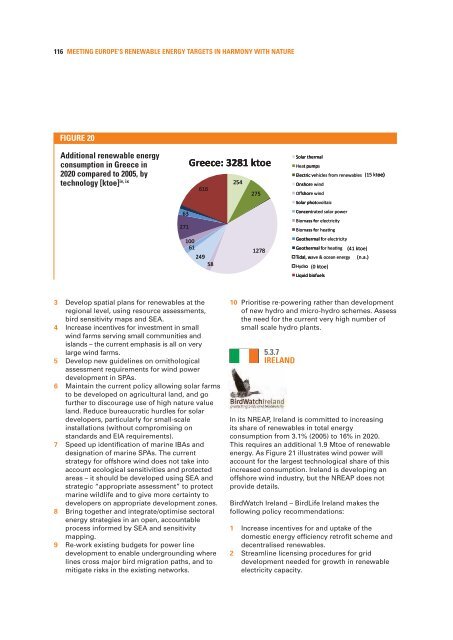Meeting Europe's renewable energy targets in harmony with - RSPB
Meeting Europe's renewable energy targets in harmony with - RSPB
Meeting Europe's renewable energy targets in harmony with - RSPB
You also want an ePaper? Increase the reach of your titles
YUMPU automatically turns print PDFs into web optimized ePapers that Google loves.
116 MEETING EUROPE’S RENEWABLE ENERGY TARGETS IN HARMONY WITH NATURE<br />
FIGURE 20<br />
Additional <strong>renewable</strong> <strong>energy</strong><br />
consumption <strong>in</strong> Greece <strong>in</strong><br />
2020 compared to 2005, by<br />
iv, ix<br />
technology [ktoe]<br />
<br />
<br />
<br />
<br />
<br />
<br />
<br />
<br />
<br />
<br />
<br />
<br />
<br />
<br />
<br />
<br />
<br />
<br />
<br />
<br />
<br />
<br />
<br />
<br />
<br />
<br />
<br />
<br />
<br />
<br />
<br />
<br />
<br />
3 Develop spatial plans for <strong>renewable</strong>s at the<br />
regional level, us<strong>in</strong>g resource assessments,<br />
bird sensitivity maps and SEA.<br />
4 Increase <strong>in</strong>centives for <strong>in</strong>vestment <strong>in</strong> small<br />
w<strong>in</strong>d farms serv<strong>in</strong>g small communities and<br />
islands – the current emphasis is all on very<br />
large w<strong>in</strong>d farms.<br />
5 Develop new guidel<strong>in</strong>es on ornithological<br />
assessment requirements for w<strong>in</strong>d power<br />
development <strong>in</strong> SPAs.<br />
6 Ma<strong>in</strong>ta<strong>in</strong> the current policy allow<strong>in</strong>g solar farms<br />
to be developed on agricultural land, and go<br />
further to discourage use of high nature value<br />
land. Reduce bureaucratic hurdles for solar<br />
developers, particularly for small-scale<br />
<strong>in</strong>stallations (<strong>with</strong>out compromis<strong>in</strong>g on<br />
standards and EIA requirements).<br />
7 Speed up identification of mar<strong>in</strong>e IBAs and<br />
designation of mar<strong>in</strong>e SPAs. The current<br />
strategy for offshore w<strong>in</strong>d does not take <strong>in</strong>to<br />
account ecological sensitivities and protected<br />
areas – it should be developed us<strong>in</strong>g SEA and<br />
strategic “appropriate assessment” to protect<br />
mar<strong>in</strong>e wildlife and to give more certa<strong>in</strong>ty to<br />
developers on appropriate development zones.<br />
8 Br<strong>in</strong>g together and <strong>in</strong>tegrate/optimise sectoral<br />
<strong>energy</strong> strategies <strong>in</strong> an open, accountable<br />
process <strong>in</strong>formed by SEA and sensitivity<br />
mapp<strong>in</strong>g.<br />
9 Re-work exist<strong>in</strong>g budgets for power l<strong>in</strong>e<br />
development to enable underground<strong>in</strong>g where<br />
l<strong>in</strong>es cross major bird migration paths, and to<br />
mitigate risks <strong>in</strong> the exist<strong>in</strong>g networks.<br />
10 Prioritise re-power<strong>in</strong>g rather than development<br />
of new hydro and micro-hydro schemes. Assess<br />
the need for the current very high number of<br />
small scale hydro plants.<br />
5.3.7<br />
IRELAND<br />
In its NREAP, Ireland is committed to <strong>in</strong>creas<strong>in</strong>g<br />
its share of <strong>renewable</strong>s <strong>in</strong> total <strong>energy</strong><br />
consumption from 3.1% (2005) to 16% <strong>in</strong> 2020.<br />
This requires an additional 1.9 Mtoe of <strong>renewable</strong><br />
<strong>energy</strong>. As Figure 21 illustrates w<strong>in</strong>d power will<br />
account for the largest technological share of this<br />
<strong>in</strong>creased consumption. Ireland is develop<strong>in</strong>g an<br />
offshore w<strong>in</strong>d <strong>in</strong>dustry, but the NREAP does not<br />
provide details.<br />
BirdWatch Ireland – BirdLife Ireland makes the<br />
follow<strong>in</strong>g policy recommendations:<br />
1 Increase <strong>in</strong>centives for and uptake of the<br />
domestic <strong>energy</strong> efficiency retrofit scheme and<br />
decentralised <strong>renewable</strong>s.<br />
2 Streaml<strong>in</strong>e licens<strong>in</strong>g procedures for grid<br />
development needed for growth <strong>in</strong> <strong>renewable</strong><br />
electricity capacity.
















